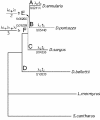Evaluation of intra- and interspecific divergence of satellite DNA sequences by nucleotide frequency calculation and pairwise sequence comparison
- PMID: 12734555
- PMCID: PMC152575
- DOI: 10.1251/bpo47
Evaluation of intra- and interspecific divergence of satellite DNA sequences by nucleotide frequency calculation and pairwise sequence comparison
Abstract
Satellite DNA sequences are known to be highly variable and to have been subjected to concerted evolution that homogenizes member sequences within species. We have analyzed the mode of evolution of satellite DNA sequences in four fishes from the genus Diplodus by calculating the nucleotide frequency of the sequence array and the phylogenetic distances between member sequences. Calculation of nucleotide frequency and pairwise sequence comparison enabled us to characterize the divergence among member sequences in this satellite DNA family. The results suggest that the evolutionary rate of satellite DNA in D. bellottii is about two-fold greater than the average of the other three fishes, and that the sequence homogenization event occurred in D. puntazzo more recently than in the others. The procedures described here are effective to characterize mode of evolution of satellite DNA.
Figures





Similar articles
-
Satellite-DNA evolutionary patterns under a complex evolutionary scenario: the case of Acrolophus subgroup (Centaurea L., Compositae) from the western Mediterranean.Gene. 2007 Dec 1;404(1-2):80-92. doi: 10.1016/j.gene.2007.09.001. Epub 2007 Sep 12. Gene. 2007. PMID: 17905542
-
Natural History of a Satellite DNA Family: From the Ancestral Genome Component to Species-Specific Sequences, Concerted and Non-Concerted Evolution.Int J Mol Sci. 2019 Mar 9;20(5):1201. doi: 10.3390/ijms20051201. Int J Mol Sci. 2019. PMID: 30857296 Free PMC article.
-
Evolutionary turnover of two pBuM satellite DNA subfamilies in the Drosophila buzzatii species cluster (repleta group): from alpha to alpha/beta arrays.Gene. 2005 Apr 11;349:77-85. doi: 10.1016/j.gene.2004.11.032. Gene. 2005. PMID: 15777676
-
Satellite DNA and chromosomes in Neotropical fishes: methods, applications and perspectives.J Fish Biol. 2010 Apr;76(5):1094-116. doi: 10.1111/j.1095-8649.2010.02564.x. J Fish Biol. 2010. PMID: 20409164 Review.
-
Satellite DNAs between selfishness and functionality: structure, genomics and evolution of tandem repeats in centromeric (hetero)chromatin.Gene. 2008 Feb 15;409(1-2):72-82. doi: 10.1016/j.gene.2007.11.013. Epub 2007 Dec 4. Gene. 2008. PMID: 18182173 Review.
References
LinkOut - more resources
Full Text Sources

